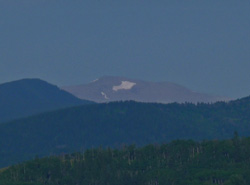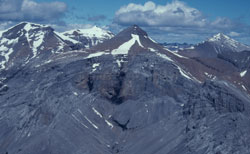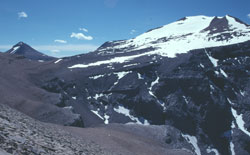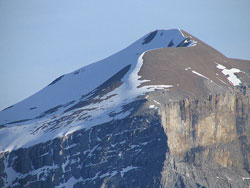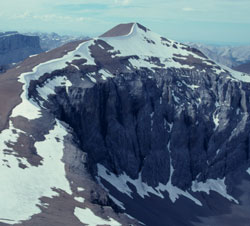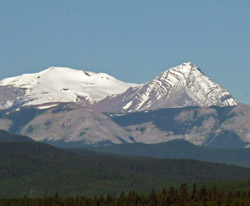
Looking southwest to Mount Cornwall (left) and Mount Glasgow
Mount Cornwall
- 2970 m (9,745ft)
- First Ascent
- Naming History
Located in the Little Elbow River Valley at the head of South Glasgow Creek
Province: Alberta
Park: Kananaskis
Headwater: Bow
Visible from Highway: 66
Ascent Party: A. Choquette
Named for: HMS Cornwall was a cruiser engaged in the Battle of the Falkland Islands during WW I.
Banded Peak, together with Mount Glasgow, Mount Cornwall, and Outlaw Peak, form a small range that lies beween the Little Elbow River to the north and the Elbow River to the south. For some reason, this group seems to attract falls of early and late season snow. Often in the late spring and early summer, when rain has fallen on nearby mountains, this group will be white with fresh snow. The late summer often sees this phenomenon as well. The "Cornwall Snowspot" is always the last accumulation of winter snow to melt in this area of the mountains and is very noticeable from the plains to the east late in the summer. It forms on the eastern slopes of Mount Cornwall, just north of the summit. Eventually it melts to become near circular shape. Most summers it eventually melts but occassionally it is still present when the next fall snows begin to cover the mountain. The first recorded ascent of Mount Cornwall was completed by Arnold Choquette, alone and on skis in 1949. Mr. Choquette was a Calgary geologist who initiated the construction of "Snowridge" in the late 1960's. The ski area is now known as Fortress Mountain. THE MARQUIS OF LORNE The Marquis of Lorne took the time to sketch this group of four peaks during an ambitious, cross-country tripe he made during his years as the Governor General of Canada (1878-1883). His connection to the Rockies extends even further. He would later marry Queen Victoria's fourth daughter, the namesake for the town of Lake Louise in Banff National Park. And an engraving of his sketch of the four peaks was made by Edward Whymper, the man who first climbed the Matterhorn in Switzerland and visited the Rockies several times in the early twentieth century. Whymper's engraving of the Marquis' sketch appeared in "Canadian Pictures", the book which the Marquis wrote about his trip. This peak is sometimes confused with Mount Cornwell in the Highwood Valley. *A hiking route to the summit is described in Gillean Daffern?s Kananaskis Country Trail Guide. For a panoramic view from the summit of Mount Cornwall visit www.canadasmountains.com. THE BATTLE OF THE FALKLAND ISLANDS Mounts Cornwall and Glasgow are two of over a dozen peaks in the Kananaskis area named after British warships of World War I. Most were ships which had participated in the Battle of Jutland in 1916, but HMS Cornwall and HMS Glasgow were both cruisers which played a significant role in the 1914 Battle of the Falkland Islands. German naval forces had been raiding commercial shipping in the south Atlantic and a much larger Royal Navy formation was dispatched to the area. The battle, although not a complete victory, freed Britain's trade and troop transport routes in that part of the world from the threat of surface raiders for the duration of the war. The Cornwall and Glasgow, together with HMS Kent, were pursuing three German warships that were trying to escape the main battle and seek refuge in Tierra del Fuego. Choosing to concentrate their attention on the German light cruiser Leipzig, HMS Glasgow engaged first, attempting to slow down the fleeing German ship and allow the Cornwall to catch up and assist. The Glasgow suffered some hits but the tactic was successful and soon HMS Cornwall came into range and, as her captain wrote, "Cornwall hit the Lepzig's foretopmast and carried it away, turned to starboard, and I poured in my whole broadside." The two English ships then engaged their wounded quarry from opposite sides, their fire becoming more and more effective as they slowly closed the range. Out of ammunition, the Leipzig fired its last two torpedoes but the British had by then retreated out of range. They then re-approached the Leipzig to see if the Germans had "struck her colours," but since her ensign was still flying, opened fire once more. Her flag still flying, the Leipzig heeled over to sink rapidly by her bows. The British ships could rescue only 18 of the 286 sailors and Captain Ellerton of HMS Cornwall, "regretted that an officer as gallant as Captain Haun of the Leipzig was not one of them."

